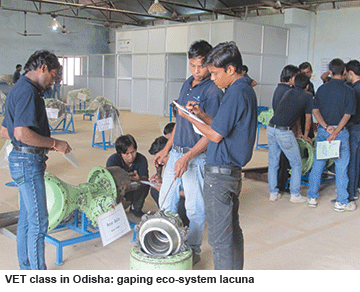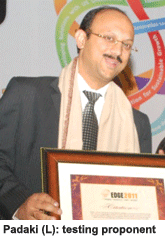The price the Indian economy has paid for under-investment in VET has been catastrophic. Shopfloor productivity in industry is one-third to one-tenth of China and OECD countries.
 PERHAPS BECAUSE of deep-rooted prejudices buried in the pernicious Hindu caste system, hands-on vocational education which would have upskilled the population, didn’t receive any worthwhile attention during the first half century since independence.
PERHAPS BECAUSE of deep-rooted prejudices buried in the pernicious Hindu caste system, hands-on vocational education which would have upskilled the population, didn’t receive any worthwhile attention during the first half century since independence.
Only in the new millennium after a small band of prescient educationists (and EducationWorld) began highlighting this gaping lacuna in the country’s education ecosystem and connected it with the rock-bottom productivity of Indian agriculture, industry and labour, did the establishment in New Delhi wake up to the need to factor vocational skilling into the education system.
Although ITIs (Industrial Training Institutes) were established by the Central government to train and skill shopfloor workers in the early years after independence, not only were they too few in number, they were also the step-children of the Union labour ministry and were saddled with outmoded syllabuses and technologies. But driven by persistent criticism from the said minority of educationists, in 2009 the Congress-led UPA-II government belatedly established the National Skill Development Corporation (NSDC) with the mandate to rapidly skill the country’s population.
NSDC’s mission is to build a sustainable ecosystem and promote skills development through provision of long-term loans to private sector vocational education and training (VET) firms, set up sector skill councils with employer engagement to prescribe standards and benchmarks, accredit training institutions to certify trainees, and encourage industry to employ trained personnel.
Refreshingly, instead of a retired bureaucrat, in a moment of lucidity UPA-II appointed S. Ramadorai, vice chairman and hitherto chief executive of Tata Consultancy Services — India’s #1 IT software and services company — and invested him with cabinet status to get NSDC off the ground. The corporation’s mandate is to ensure that private sector VET providers skill 150 million youth and workers by year 2020.
“for indians and india to prosper, it is necessary that long-term planning of education and training should allow 90-95 percent of the population to learn a skill, a trade or a competence. In fast developing nations such as China, Malaysia, Singapore, Thailand, Indonesia and developed countries — Japan, Germany, Korea, Taiwan, UK, Australia, Canada — this is the reality. At any given time, at least 5 percent of the total population should be receiving some sort of VET. This translates into 55 million people getting VET in India,” vocational education evangelist Krishan Khanna told EducationWorld earlier this year when this publication featured a major cover story titled ‘India’s belated skilling revolution’ (EW April).
An alumnus of IIT-Kharagpur and promoter of two BSE-listed companies (Hoganas India and Denora India), Khanna quit the corporate world in 1992 to morph into a pioneer VET evangelist. The same year he promoted iWatch, an NGO which has played a major role in impacting the importance of VET education upon the Central and state governments and the public (including EducationWorld).
According to iWatch, currently 90 million youth are enrolled in 500,000 VET institutions in China and 11 percent of its total labour force of 816 million has received formal VET education. In sharp contrast, the number of youth enrolled in India’s 11,800 VET institutions (including 5,114 ITIs run by the Union ministry of labour) is a mere 3.5 million, and only 8-10 percent of 30 million workers in the organised sector of industry, i.e large companies, have formal VET certification. The rest of India’s 480 million strong labour force is at best informally trained in the learning-by-doing tradition of crafts families. On the other hand in Germany, USA and the UK, 75, 65 and 70 percent of their national workforce respectively have experienced formal VET education.
The price the Indian economy has paid for under-investment in VET in particular, has been catastrophic. Shopfloor productivity of blue-collar workers in industry and manufacturing is one-third to one-tenth of their counterparts in China and the developed OECD countries. Yet perhaps the worst impact of the neglect of elementary education and VET has been experienced by the vast majority of rural citizens whose average per capita income is a mere Rs.40,000 per year — equivalent to less than $2 per day.
Although under Ramadorai’s leadership NSDC has got off to a good start — he claims that in the year ended March 31, 2.5 million youth and workers were trained and skilled by NSDC funded partner VET firms, and in 2,500 NSDC established VET centres in 350 districts countrywide — with the new BJP-led government taking charge in New Delhi, the fate of NSDC is uncertain. While it would be foolish to contemplate that the new government would dismantle NSDC, it’s entirely possible it may slow its momentum, given its seeming preoccupation with a revivalist agenda for Indian education (see editorial p.10).
However Madan Padaki, trustee of the Bangalore-based Head Held High Foundation (regd. 2010) and promoter-chairman of Head Held High Services Pvt. Ltd ( H3S, estb. 2012) — VET training institutions which claim they can transform completely English illiterate village youth into job-ready BPO (business process outsourcing) employees within six months under their Ruban Shakti learning programme — is enthused with several provisions of the first Union budget presented by the Modi government on July 10.
“It’s heartening that the Union Budget 2014-15, in many ways, is a ‘Rubanomics’ budget — addressing the needs of the new rural-urban partnership. The government has begun well in recognising the importance of skill building, entrepreneurship and digital inclusion in driving economic progress, especially rural prosperity,” says Padaki, who adds that H3S has established 16 Rubanomics training/learning centres in Karnataka and Andhra Pradesh in which over 1,000 illiterates and school graduates have been trained. Of them 90 percent are already employed in 15 corporates, firms and business enterprises in the two states at an average starting wage of Rs.7,500 per month.
According to Padaki, provisions in the Union Budget 2014-15 which augur well for the dissemination of VET countrywide include the proposal to establish the new Skill India training programme which will provide VET to promote employability and entrepreneurial skills; Rs.100 crore for expansion of employment exchanges into counseling centres; Rs.100 crore for establishing a Start-Up Village Entrepreneurship Programme; Rs.200 crore allocation to create a technology centre framework that will promote innovation, entrepreneurship and agro-industry; Rs.200 crore to encourage start-ups by scheduled caste and scheduled tribe youth; Rs.500 crore allocated for a National Rural Internet and Technology Mission for services in villages and schools, training in IT skills and e-kranti for government service delivery and governance.
“In our seven years of working with unskilled rural youth in some of the remotest districts of Karnataka, we have come to believe that such interventions have huge potential to transform, and unlock the talent of people we have identified as ‘Rubans’ — rural folk with urban aspirations. They have raw talent, entrepreneurial drive and access to technology. Undoubtedly, this budget offers much to Rubans, and we are excited about the possibilities of truly energising the rural economy by leveraging the power of their entrepreneurial spirit through technology,” says Padaki.
Given Padaki’s commitment to providing VET to India’s neglected rural masses and the proven record of H3S’ success in this endeavour, Padaki’s observation on the Union Budget 2014-15, the first major policy statement of the newly-elected BJP-NDA government can’t be taken lightly. One hopes the Modi sarkar doesn’t allow its hindutva prejudices and other peripheral issues to slow down the momentum of NSDC, and the traction that India’s long-overdue VET skills development agenda has belatedly acquired.
Also read: Vocational education imperative



























